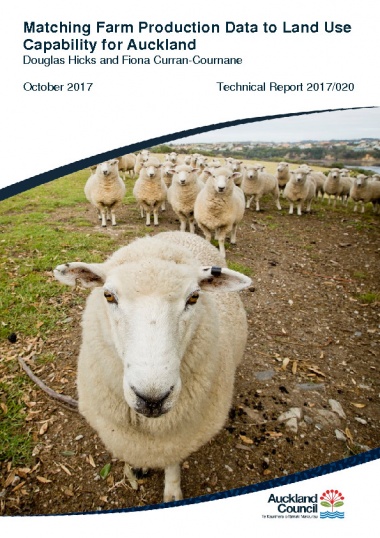The primary sector makes up around three quarters of New Zealand’s exports, of which 56 per cent is food production. Auckland’s small land area (2% of New Zealand) contributes 25 per cent of its vegetable production. Maintaining and increasing agricultural productivity entails the promotion of sustainable land management. A new policy in the Auckland Unitary Plan (B8. 2.5) encourages ‘land management practices that retain the physical and chemical capability of soils’, recognising the significance of this valuable resource.
Land use capability (LUC) classification is one of the tools used by land and water advisors to help farmers and communities sustain land management on individual farms and within whole catchments. LUC maps have been historically, and are currently, used by researchers, rural industry, policy-makers and planners to advise decision-makers about the region's productive capability. For rural parts of Auckland the maps help underpin land use planning decisions whether it be for resource consents, plan change procedures (often supplemented by LUC site inspection and mapping) or while preparing district, regional or unitary plans. It is therefore imperative that LUC maps be underpinned by defensible and robust science that is able to withstand close scrutiny through planning hearings and court procedures.
In Auckland there have been issues with using and interpreting existing LUC maps for planning and policy purposes:
• different LUC units are mapped on similar soils, north and south of the city
• attached estimates of productive potential (livestock carrying capacity, radiata pine site index, maintenance fertilizer requirement) vary for LUC units on similar soils north and south of Auckland
• no estimates of vegetable, fruit or crop yield are attached to the LUC units on productive soils
• there are many instances where estimates overlap – or are the same – for LUC units which clearly differ in physical characteristics (so might be expected to differ in productive potential).
In response to the issues, the objectives of this report are to:
1. Update estimates of LUC units' productive potential, so they match measured yields.
2. Standardise estimates for LUC units on similar soils, so they become consistent north and south of Auckland.
3. Develop a way to express productive potential of LUC classes throughout Auckland.
4. Attach outputs to the region-wide geospatial LUC layer for Auckland.
The report documents how pasture yield data from field trials have been used to create new pasture yield estimates and updated livestock carrying capacities. Vegetable, fruit and crop yields for LUC units are not included in the report because measured yields are not readily available.
Meanwhile, the new pasture yield estimates provide a way to compare productive potential of LUC classes 1 to 8 throughout Auckland. They will not only defensibly inform future policy and land use planning decisions, but will also assist with land management advice to rural communities about the impacts of various farm management scenarios, such as retiring marginal land or fencing off certain distances from streams, on agricultural production.
Auckland Council technical report, TR2017/020
See also
Farm-scale land use capability classification for Auckland, TR2017/016
Integrating the FARMLUC classification into planning and policy decision-making
